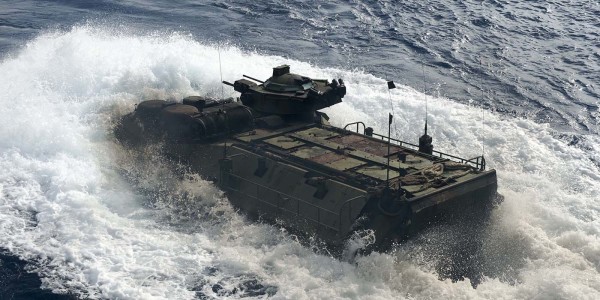The Marine Corps may be full speed ahead with its new Amphibious Combat Vehicle, but the service’s first new amphibious vehicle since the Vietnam War has plenty of problems that require redress, according to a new report from the Pentagon’s top weapons tester.
According to a new report from Defense Department’s operational testing and evaluation arm, the new ACV demonstrated several “vulnerabilities” in its survivability and force protection capabilities when it comes to kinetic threats, although the specifics are detailed in a classified annex.
Among the technical problems listed in the OT&E report is a low mean time between operational mission failures of roughly 39 hours between issues, well below the reliability requirement of 69 hours, meaning that the system broke down way more often while acceptable. And while the ACV generally demonstrated “good operational availability and maintainability,” most of the failures involved the vehicle’s vaunted remote weapon station, its hatch and ramp sensors, and various suspension components.
Even worse: for infantry Marines, it apparently makes for an incredibly uncomfortable ride — one that’s hard to escape in case of emergency.
“Due to the placement and number of blast mitigating seats, interior space within the ACV is limited, making rapid ingress and egress difficult,” according to the OT&E report. “Infantry Marines noted that the troop seats were not contoured to fit body armor configurations, leading to discomfort during long-range ship-to-objective missions.”
This isn’t just a frustrating development for anyone who’s found themselves stuck in the belly of one of the Corps’ current fleet of aging Amphibious Assault Vehicles, but a concerning one given the recent sinking of an AAV this past summer during training off San Clemente Island in California.
Nine crew members were killed, making the incident the Corps’ deadliest training accident in the history of the AAV.
While service officials have launched two separate investigations into the incident, a 2014 Naval Postgraduate School study of Marine Corps assault amphibian vehicle emergency egress scenarios found that more Marines put into the back of the AAV, the longer it will take for them to egress from the vehicle due to the lack of maneuverability afforded by their body armor and other essential gear.
“Designers of future vehicles must consider the relevant anthropometric measures of the entire infantry population and build a vehicle in which egress is not impeded for Marines of any size,” according to the study — measures that the new ACV doesn’t appear to have taken into account, according to the OT&E report.
Despite this, the Corps is plowing forward with the new vehicles, and the first ACVs hit the fleet in early November during a redesignation ceremony for Co. D, 3rd Assault Amphibian Battalion, 1st Marine Division at at Marine Corps Air Ground Combat Center Twentynine Palms in California.
In December, the service officially announced that it has approved the ACV for full-rate production, which means the Corps “can build and field higher quantities of the ACV at a sustained rate over the next several years,” according to a Marine Corps Systems Command release.
“We’re providing Marines with a modern, armored personnel carrier that offers tremendous capability with respect to survivability,” Col. Kirk Mullins, program manager for Advanced Amphibious Assault at PEO Land Systems, said in a statement at the time. “The ACV gives the Marine Corps a capable platform operational across the full-range of military operations.”
Related: Check out all the firepower on the Marine Corps’s first new amphibious battlewagon since Vietnam

























